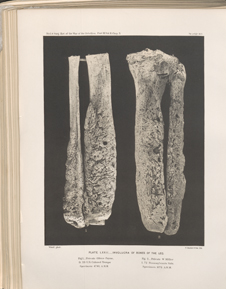Title: Payne, Oliver
Source text: The Medical and Surgical History of the War of the Rebellion. (1861-65.), Part 3, Volume 2 (Washington, DC: Government Printing Office, 1883), 528, 317.
Civil War Washington ID: med.d2e20228
TEI/XML: med.d2e20228.xml
CASE 771.—Private O. Payne, Co. D, 20th Colored Troops, aged 19 years, was wounded in the right foot, near Petersburg, June 7, 1864, and entered Mount Pleasant Hospital, at Washington, three days afterwards. Assistant Surgeon C. A. McCall, U. S. A., reported: "Accidental gunshot wound through tendo-achillis, passing through the ankle joint and emerging almost at right angle with the line of entrance, literally grinding the astragalus and part of the os calcis. Sanguineous fluid was discharged from the wounds, and the foot became somewhat œdematous as far as above the malleoli. Two weeks after the patient's admission his pulse grew weaker, more compressible, and frequent, which was attended by loss of "appetite and sleep. On June 27th, an anæsthetic consisting of equal parts of ether and chloroform was administered, and the leg was amputated by the circular method, by Acting Assistant Surgeon A. Transue, the bone being divided one and a half inches above the malleoli. The patient reacted finely, and after the operation his appetite improved, he slept well, and the parts looked favorable." On October 8th, he was transferred to hospital at New Albany, where a second operation was performed by Acting Assistant Surgeon W. A. Clapp, who contributed the following description of the case: "The patient stated that he contracted syphilis previous to being wounded. Extensive necrosis of the shafts of the tibia and fibula followed the first amputation, and the pain and discharge from the stump became so great as to necessitate a re-amputation, which was performed by the circular method, three inches below the knee, on March 18, 1865. At the time of the operation firm sequestra had formed and there was great swelling of the soft parts. The subsequent progress was favorable." The patient was ultimately discharged from service, at the Joe Holt Hospital, Jeffersonville, August 1, 1865, and pensioned, and one year afterwards he was furnished with an artificial limb of the Palmer patent. The bones removed at the second amputation were subsequently contributed to the Museum by Dr. T. W. Fry, late Surgeon U. S. V., who at the same time stated that the man was in good health and walking about on crutches, with a good stump, which had healed kindly. The specimen is numbered 4740 of the Surgical Section, and is represented in PLATE LXXII, FIGURE 1, opposite page 317, ante. The pensioner was paid March 4, 1880.
